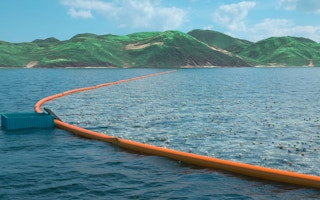Weekend beach cleanup campaigns would no longer do. Dubbed the world’s first and largest cleanup in history, a start-up foundation’s massive campaign to rid the oceans of plastic pollution is a step closer to reality after it signed an agreement with a Japanese island city to pilot its innovative method of collecting plastic.
To continue reading, subscribe to Eco‑Business.
There's something for everyone. We offer a range of subscription plans.
- Access our stories and receive our Insights Weekly newsletter with the free EB Member plan.
- Unlock unlimited access to our content and archive with EB Circle.
- Publish your content with EB Premium.
The Ocean Cleanup, founded by a 20-year-old Dutch aerospace engineering student, is looking to deploy by mid-2016 its technology which uses floating booms to collect plastic waste in the ocean. The method capitalises on the natural flow of the ocean’s rotating currents called gyres which passively concentrate the plastic in one location.
Boyan Slat, the chief executive of The Ocean Cleanup, announced on May 20 at Seoul Digital Forum technology conference the plan to pilot the technology off the coast of Tsushima Island, part of the Nagasaki Prefecture in Japan and situated in the Korea Strait.
“Taking care of the world’s ocean garbage problem is one of the largest environmental challenges mankind faces today. Not only will this first cleanup array contribute to cleaner waters and coasts but it simultaneously is an essential step towards our goal of cleaning up the Great Pacific Garbage Patch,” noted Slat in a statement.
The Great Pacific Garbage Patch is a term used to describe the concentration of marine trash found in some areas of the Pacific Ocean, particularly in the North Pacific. The marine debris is collected by gyres or the natural rotation of the ocean’s currents.
United States-based scientists said in a study published in February 2015 that the amount of plastic waste entering the ocean stream globally reaches up to 8 million tonnes every year.
“
Not only will this first cleanup array contribute to cleaner waters and coasts but it simultaneously is an essential step towards our goal of cleaning up the Great Pacific Garbage Patch.
Boyan Slat, founder and chief executive officer, The Ocean Cleanup
Meanwhile, the United Nations Environment Programme has calculated that the impact of plastic waste to the marine ecosystem amounts to US$13 billion each year, and is particularly damaging to fishing and tourism industries. It is also the cause of death of marine species and the destruction of critical coral reef habitats.
The Ocean Cleanup said their study in 2014 confirmed that the passive system of collecting the waste is more feasible and cheaper than investing in other methods that use vessels and nets, which could take thousands of years and also generate huge amounts of carbon dioxide emissions.
The planned deployment of floating barriers spanning 2,000 metres along the coast of Tsushima is currently being studied, the non-profit group said. This will be the first time the Ocean Cleanup system will be operational; it aims to test the durability of the barriers and determine the efficiency of the system in real-life conditions for at least two years.
The group claims it will also be the world’s longest floating structure to be deployed in the ocean, beating Tokyo Mega-Float, the 1,000-metre floating runway in Tokyo Bay.
The government of Tsushima Island, which signed the agreement with Ocean Cleanup, is evaluating what can be done with the plastic, and is looking into the possibility of turning it into an alternative energy source, it added.
The current passing through Tsushima island brings about 30,000 cubic metres of trash onto its shores every year, and if collected manually would cost about US$5 million each year, explained the non-profit group.
Since The Ocean Cleanup started in 2013, it has received support from 100 volunteer scientists and engineers, who back the concept. The group, registered in Netherlands as a foundation, also raised US$2.1 million in September last year through a crowdfunding campaign.
If the current plan succeeds, it looks to scale up and deploy a 100 kilometre-long system between Hawaii and California to clean up about half of the garbage patch in the Pacific.
It estimates that a single 100km array of floating booms, deployed for 10 years, can passively remove up to 42 per cent of the trash in the region.
However, not everyone seems too excited about Slat’s idea as some critics claim it is not possible and the booms would only end up into pieces, adding more plastic into the ocean. Chris Clarke wrote in KCET six reasons why the plan may not work out as intended and noted that the ocean plastic does not behave as it is claimed by Slat’s group and that the project could harm wildlife.
This article has been updated to reflect other points of view on the project.










